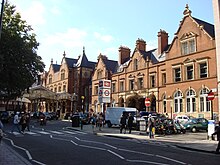Marylebone Railway Station
Marylebone is a train station northwest of central London in the borough of Marylebone . It is a terminus and the smallest long-distance station in London. The railway company Chiltern Railways operates trains to Birmingham from here . Under the station is a station of the Bakerloo Line of London Underground . In 2014, 11.758 million passengers used the station, a further 13.30 million the subway station.
railroad
Plant and operation
The station has six platforms: five date from 1899, one was demolished in the late 1960s and two new ones were added in September 2006. Marylebone is the only terminus in London without an electrified access route and, apart from Blackfriars, the only one that is not operated by the rail infrastructure company Network Rail . Instead, Chiltern Railways , which is part of the Deutsche Bahn group, has been assigned to Arriva since 2011 .
Chiltern Railways suburban and express trains run on the Chiltern Main Line from London to Aylesbury , High Wycombe , Bicester , Banbury , Leamington Spa , Stratford-upon-Avon , Birmingham (Snow Hill) and Kidderminster .
history
The station was opened on March 15, 1899. It was the starting point of the Great Central Main Line , the last main railway line to London built by the Great Central Railway (GCR). The station building, designed by Henry William Braddock, the engineer of the GCR, is in a baroque style. Originally ten platforms were planned, but the construction of the railway line turned out to be much more expensive than planned and almost led to the bankruptcy of the company. In order to save costs, the station had to be massively reduced to five platforms, four of them in the hall and one to the west of it outdoors.
The Great Central Railway connected London with Aylesbury, Rugby , Leicester , Nottingham , Sheffield and Manchester . The volume of traffic was never particularly high, however, as the railway line was built relatively late and could not prevail against the established lines (especially the Midland Railway ). The route also ran through predominantly rural areas. In contrast to the relatively low level of passenger traffic, however, the volume of goods traffic was high.
In 1964, several scenes from the Beatles film Yeah Yeah Yeah were filmed at Marylebone Station . From 1960, no trains ran beyond Nottingham. In 1966, British Rail closed almost all routes north of Aylesbury as a result of an extensive shutdown program ( Beeching ax ) and traffic continued to decrease. Marylebone only served as a starting point for local trains to Aylesbury and High Wycombe, but due to lack of investment, the station slowly fell into disrepair. In the early 1980s there were plans to close the station entirely, divert trains to Paddington , and convert Marylebone into an intercity bus terminal. But these plans were eventually dropped.
The creeping decline was halted in the late 1980s when British Rail decided to divert numerous trains from the congested Paddington Station to Marylebone. The station has undergone a million dollar renovation (financed by the sale of the former freight yard area), two new platforms were built and the suburban trains received modern rolling stock. However, the two new platforms were closed a few years later to make room for a residential complex.
After the privatization of British Rail, the new company Chiltern Railways took over the operation of the station in 1996 and among other things introduced a new express train connection to Birmingham , which proved to be a complete success. The closure of the parking facilities at Marylebone station and the opening of a new depot in Wembley in 2006 created the space required to build two more platforms. In the same year, a new company called Wrexham & Shropshire was founded , which began operating trains to Wales in early 2008 and ceased operations in January 2011.
Subway
The underground station under the train station is served by trains on the Bakerloo Line . Access is via escalators from the main hall, which is also where the London Underground counters are located. The station opened on March 27, 1907. It was initially called Great Central; the name was changed to Marylebone on April 15, 1917. The current access has existed since 1943. Previously, the subway had its own, designed by Leslie Green building with elevators at the intersection of Harewood Avenue and Harewood Row. The building was demolished in 1971 and is now a hotel on its site.
See also
Web links
Individual evidence
- ↑ Dieter Hamblock and Christoph Groneck : Railways in London = Railway History Special 3rd Hövelhof 2017. ISBN 978-3-946594-06-2 , p. 55.
- ↑ COUNTS - 2014 - annual entries & exits. (PDF, 44 kB) (No longer available online.) Transport for London, 2015, archived from the original on February 21, 2016 ; accessed on September 3, 2018 (English).
- ^ Office of Rail Regulation - station usage
- ↑ Dieter Hamblock and Christoph Groneck : Railways in London = Railway History Special 3rd Hövelhof 2017. ISBN 978-3-946594-06-2 , p. 57.
| Previous station | Transport for London | Next station | ||
|---|---|---|---|---|
| Edgware Road | Bakerloo Line | Baker Street | ||
| Previous station | National Rail | Next train station | ||
| Harrow-on-the-Hill |
Chiltern Railways London − Aylesbury Line |
final destination | ||
| Wembley Stadium |
Chiltern Railways Chiltern Main Line |
|||
| Banbury |
Wrexham & Shropshire London – Wrexham |
|||
Coordinates: 51 ° 31 '22 " N , 0 ° 9' 47" W.


